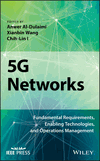Full-Duplex System Design for 5G Access
Abstract
In order to meet the new requirements of 5G networks and to overcome the limits in nowadays systems, it is anticipated that revolutionary technologies, including full-duplex (FD), should be introduced to existing and evolving systems, like LTE-A and Wi-Fi. This chapter reviews the self-interference cancellation technologies that enable full-duplex operation. It provides a general overview of system design challenges for full-duplex cellular systems with an emphasis on interference complications for FD small cell access. The chapter presents practical interference mitigation schemes to treat base station (BS)-to-BS and UE-to-UE interferences, including null beam forming, uplink (UL) power control, joint intracell scheduler, channel quality indicator (CQI) feedback, and reference signal design. It demonstrates the system performance with the proposed design in full-duplex system-level-simulator, by considering various indoor/outdoor scenarios using 3GPP models. The chapter also demonstrates that with proper interference mitigation, more than 1.7 × spectrum efficiency gains can be achieved in FD networks.



